Competency Based Questions for Class 10 Science Chapter 2 Acids, Bases and Salts
Competency Based Questions are new type of questions asked in CBSE Board exam for class 10. Practising the following Competency Based Questions will help the students in facing Board Questions.
Hint: Recall the tastes of acids and bases in order to point out if given food items contain an acid or a base.
Question.1. Which fruit is basic in nature?
(a) Apples
(b) Oranges
(c) Strawberries
(d) banana
Answer. (d) banana
Question.2. A student listed some food items as shown:
1. Lemon Juice
2. Baking soda
3. Broccoli
4. Curd
Which option classifies the food items on the basis of acidic and basic nature of food?
(a) Acid: Lemon juice, broccoli. Base: Baking soda, Curd
(b) Acid: Lemon juice, Curd. Base: Baking soda, Broccoli
(c) Acid: Lemon juice, Baking soda. Base: broccoli, Curd
(d) Acid: Baking soda, broccoli. Base: Lemon juice, Curd
Answer. (b) Acid: Lemon juice, Curd. Base: Baking soda, Broccoli
Hint: Observe the action of given substances with various indicators, in order to categorize them as acids or bases.
Question.3. A basic solution is added to a test tube. A blue and red litmus paper is dipped into the basic solution. What will happen to both litmus papers?
(a) Blue litmus paper: changes colour; Red litmus paper: changes colour
(b) Blue litmus paper: changes colour; Red litmus paper: no colour change
(c) Blue litmus paper: no colour change; Red litmus paper: changes color
(d) Blue litmus paper: no colour change; Red litmus paper: no colour change
Answer. (c) Blue litmus paper: no colour change; Red litmus paper: changes color
Question.4. A solution of pH 2 is filled in two separate beakers. A few drops of methyl orange and phenolphthalein are added into separate solutions. How will the colour of the indicators change?
(a) Methyl orange: red; Phenolphthalein: pink
(b) Methyl orange: orange; Phenolphthalein: pink
(c) Methyl orange: Red; Phenolphthalein: colourless
(d) Methyl orange: orange; Phenolphthalein: colourless
Answer. (c) Methyl orange: Red; Phenolphthalein: colourless
Hint: Detect the formation of hydrogen gas when a metal reacts with an acid or a base, in order to confirm the presence of an acid/ base given an unknown compound.
Question.5. When dilute sulphuric acid is added to a solid X, a gas Y is formed along with the formation of the salt of the solid. What could be X and Y?
(a) X: zinc; Y: oxygen
(b) X: zinc; Y: hydrogen
(c) X: copper; Y: oxygen
(d) X: carbon; Y: hydrogen
Answer. (b) X: zinc; Y: hydrogen
Question.6. When a base reacts with a metal, it forms a salt and hydrogen gas is released. By what method the presence of hydrogen can be detected?
(a) by water
(b) by litmus paper
(c) by methyl orange
(d) by a burning candle
Answer. (d) by a burning candle
Hint: Detect the formation of carbon dioxide when a metal carbonate/ bicarbonate reacts with acid, in order to detect the presence of acid given an unknown compound.
Question.7. A student did an activity in which he added sodium bicarbonate to hydrochloric acid. It forms the carbon dioxide gas. The gas released is passed through lime water. What change will be observed in lime water
(a) bubbles are formed
(b) white precipitate is formed
(c) the solution becomes colourless
(d) the colour of solution becomes red
Answer. (b) white precipitate is formed
Question.8. A metal carbonate reacts with a solution X which forms a salt, water, and a gas Y. What are X and Y?
(a) X: hydrochloric acid; Y: hydrogen
(b) X: sodium hydroxide; Y: hydrogen
(c) X: hydrochloric acid; Y: carbon dioxide
(d) X: sodium hydroxide; Y: carbon dioxide
Answer. (c) X: hydrochloric acid; Y: carbon dioxide
Hint: Analyse the reaction taking place between an acid and a base (alkalis, metal oxides) using an indicator.
Question.9. Which equation for the reaction between hydrochloric acid and sodium hydroxide is correct?
(a) HCl+NaOH \rightarrow NaCl+H_{2}O
(b) HCl+2NaOH \rightarrow Na_{2}Cl+H_{2}O
(c) 2HCl+NaOH \rightarrow 2NaCl+H_{2}O
(d) 2HCl+NaOH \rightarrow NaCl+H_{2}O
Answer. (a) HCl+NaOH \rightarrow NaCl+H_{2}O
Question.10. A student placed 10 mL HCl and NaOH in two separate beakers as shown.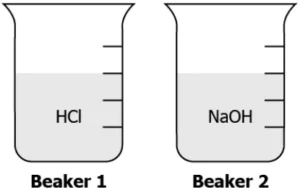
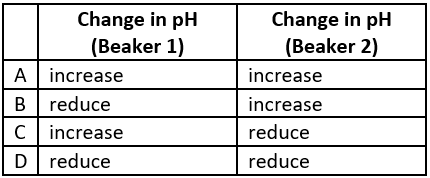
(a) A
(b) B
(c) C
(d) D
Answer. (c) C
Hint: Analyse the reaction taking place between an acid and a base (alkalis, metal oxides) using an indicator.
Question.11. The equation shows the reaction of metal oxide with acid.
Metal oxide + Acid \rightarrow X + Water
What is X?
(a) Salt
(b) Base
(c) Hydrogen
(d) Carbon dioxide
Answer. (a) Salt
Question.12. An oxide of element P is added to an acid where it forms salt and water. The table shows the possible value of pH and the type of element before the reaction.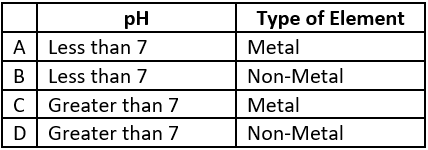
(a) A
(b) B
(c) C
(d) D
Answer. (a) A
Hint: Write down the ions present in aqueous solution of an acid or a base, in order to explain why aqueous acid/ base conduct electricity.
Question.13. A student learns that acid and base can conduct electricity because they have ions present in it.
What are the ions present in acid and base?
(a) acid: H^{+}; base: H^{+}
(b) acid: H^{+}; base: OH^{-}
(c) acid: OH^{-}; base: H^{+}
(d) acid: OH^{-}; base: OH^{-}
Answer. (b) acid: H^{+}; base: OH^{-}
Question.14. A student makes an arrangement to test the electrical conductivity of distilled water as shown.
(a) the bulb needs DC source to glow
(b) the water never conducts electricity
(c) the graphite is bad conductor of electricity
(d) the distilled water does not have ions present in it
Answer. (d) the distilled water does not have ions present in it
Hint: Detect the strength of given substances based on their position in the pH scale.
Question.15. The image shows the pH values of four solutions on a pH scale.
(a) A and B
(b) B and C
(c) C and D
(d) A and D
Answer. (c) C and D
Question.16. The image shows five solutions labelled on a pH scale.
(a) Strongest acid: B; Strongest base: E
(b) Strongest acid: A; Strongest base: C
(c) Strongest acid: A; Strongest base: E
(d) Strongest acid: B; Strongest base: C
Answer. (c) Strongest acid: A; Strongest base: E
Hint: Explain the effect of pH change in animals, plants and environment in order to learn suitable pH range for survival.
Question.17. A student learns that plants grow best when the pH of the soil is slightly acidic. Which range of pH is most suited for plant growth?
(a) 1 – 3
(b) 5.5 – 7
(c) 7 – 9
(d) 11 – 14
Answer. (b) 5.5 – 7
Question.18. A sting from insect A has pH of 6. The table shows the pH of four substances.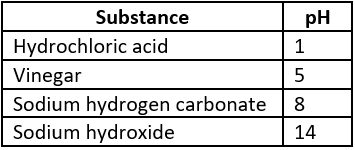
(a) Vinegar
(b) sodium hydroxide
(c) hydrochloric acid
(d) sodium hydrogen carbonate
Answer. (b) sodium hydroxide
Hint: Identify the positive and negative radicals present in a salt, in order to predict a salt’s family and pH range.
Question.19. The equation shows the reaction of hydrochloric acid with sodium hydroxide.
HCl+NaOH \rightarrow 2NaCl+H_{2}O
If the pH of the salt is 7, what are the positive and negative radicals in the salt?
(a) Na – negative radical; Cl – positive radical
(b) Na – positive radical; Cl – negative radical
(c) Na – positive radical; Cl – positive radical
(d) Na – negative radical; Cl – negative radical
Answer. (b) Na – positive radical; Cl – negative radical
Question.20. A scientist in a chemistry lab wants to make salt of pH 5.5 using acid and base. The table shows the acid and base present in the lab.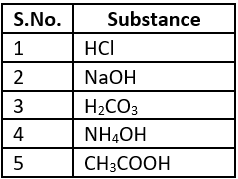
(a) HCl and NaOH
(b) H_{2}CO_{3} and NaOH
(c) HCl and NH_{4}OH
(d) CH_{3}COOH and NaOH
Answer. (c) HCl and NH_{4}OH
Hint: Outline the process of formation of sodium hydroxide in order to explain its manufacture using common salt.
Question.21. A student learns that when sodium chloride reacts with water, it forms sodium hydroxide. Which type of reaction results in the formation of sodium hydroxide?
(a) combination reaction
(b) displacement reaction
(c) neutralization reaction
(d) decomposition reaction
Answer. (d) decomposition reaction
Question.22. Which option shows a balance equation of the formation of sodium hydroxide?
(a) Na_{2}Cl+2H_{2}O \rightarrow 2NaOH+2HCl
(b) 2NaCl+2H_{2}O \rightarrow 2NaOH+2HCl
(c) NaCl+2H_{2}O \rightarrow NaOH+Cl_{2}+H_{2}
(d) 2NaCl+2H_{2}O \rightarrow 2NaOH+Cl_{2}+H_{2}
Answer. (d) 2NaCl+2H_{2}O \rightarrow 2NaOH+Cl_{2}+H_{2}
Hint: List the properties & explain the preparation/ manufacture some important compounds of Sodium. (bleaching powder, baking soda and washing soda) in order to explain their manufacture using common salt.
Question.23. Which of the following is the best possible application of Calcium oxychloride?
(a) to disinfect the water
(b) to make the water soft
(c) to reduce the pH of water
(d) to change the state of water
Answer. (d) to change the state of water
Question.24. The chemical reaction shows the reactants for the formation of baking soda.
NaCl+H_{2}O+CO_{2}+NH_{3} \rightarrow X+Y
What are X and Y?
(a) X: HCl ; Y: NaHCO_{3}
(b) X: NH_{4}Cl ; Y: NaHCO_{3}
(c) X: NH_{4}Cl ; Y: NaHCO_{2}
(d) X: NH_{3}Cl ; Y: NaHCO_{3}
Answer. (b) X: NH_{4}Cl ; Y: NaHCO_{3}
Question.25. What is the use of washing soda?
(a) to make the water alkaline
(b) to change the state of water
(c) to lower the temperature of the water
(d) to remove the permanent hardness of water
Answer. (d) to remove the permanent hardness of water
Question.26. Washing soda is obtained from the recrystallization of sodium carbonate. How is sodium carbonate obtained from baking soda?
(a) by heating the baking soda
(b) by adding water to baking soda
(c) by reacting the baking soda with acid
(d) by reacting the baking soda with base
Answer. (a) by heating the baking soda
Hint: Demonstrate the activity of heating copper sulphate crystals and change in colour, in order to detect the presence of water of crystallisation.
Question.27. When water of crystallization is removed from copper sulphate solution, how does the colour of the salt change?
(a) from blue to red
(b) from white to red
(c) from white to blue
(d) from blue to white
Answer. (d) from blue to white
Question.28. A student has three sample of copper sulphate crystals in separate test tube X, Y and Z. The colour of copper sulphate in X is blue, in Y is white and in Z is blue. Which test tube require heating to remove water of crystallization?
(a) only Y
(b) only Z
(c) both X and Z
(d)both Y and Z
Answer. (c) both X and Z




